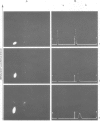Abstract
The regulation of histone H1O content throughout the cell cycle of non-synchronized Chinese hamster ovary (CHO) cells has been studied using double fluorescent staining and flow cytofluorometry. In exponentially growing cells, the amount of H1O was found to be proportional to the DNA content of the cells, indicating that the protein is synthesized throughout the cell cycle. However, when cells were arrested in G1 at saturation density the amount of H1O was greater than that found in G1 cells of the exponentially growing population. In contrast, the levels of H1-1 were the same for G1 cells of both populations. These results show that the regulation of H1O accumulation differs from that of other histones.
Full text
PDF




Images in this article
Selected References
These references are in PubMed. This may not be the complete list of references from this article.
- Cambiaso C. L., Goffinet A., Vaerman J. P., Heremans J. F. Glutaraldehyde-activated aminohexyl- derivative of Sepharose 4B as a new verstile immunoabsorbent. Immunochemistry. 1975 Apr;12(4):273–278. doi: 10.1016/0019-2791(75)90175-5. [DOI] [PubMed] [Google Scholar]
- D'Anna J. A., Gurley L. R., Becker R. R., Barham S. S., Tobey R. A., Walters R. A. Amino acid analysis and cell cycle dependent phosphorylation of an H1-like, butyrate-enhanced protein (BEP; H1(0); IP25) from Chinese hamster cells. Biochemistry. 1980 Sep 2;19(18):4331–4341. doi: 10.1021/bi00559a029. [DOI] [PubMed] [Google Scholar]
- D'Anna J. A., Gurley L. R., Tobey R. A. Syntheses and modulations in the chromatin contents of histones H1 degrees and H1 during G1 and S phases in Chinese hamster cells. Biochemistry. 1982 Aug 17;21(17):3991–4001. doi: 10.1021/bi00260a014. [DOI] [PubMed] [Google Scholar]
- Gjerset R., Gorka C., Hasthorpe S., Lawrence J. J., Eisen H. Developmental and hormonal regulation of protein H1 degrees in rodents. Proc Natl Acad Sci U S A. 1982 Apr;79(7):2333–2337. doi: 10.1073/pnas.79.7.2333. [DOI] [PMC free article] [PubMed] [Google Scholar]
- HU F., CARDELL R. R. THE ULTRASTRUCTURE OF PIGMENTED MELANOMA CELLS IN CONTINUOUS CULTURE. J Invest Dermatol. 1964 Jan;42:67–79. doi: 10.1038/jid.1964.15. [DOI] [PubMed] [Google Scholar]
- Keppel F., Allet B., Eisen H. Appearance of a chromatin protein during the erythroid differentiation of Friend virus-transformed cells. Proc Natl Acad Sci U S A. 1977 Feb;74(2):653–656. doi: 10.1073/pnas.74.2.653. [DOI] [PMC free article] [PubMed] [Google Scholar]
- Laemmli U. K. Cleavage of structural proteins during the assembly of the head of bacteriophage T4. Nature. 1970 Aug 15;227(5259):680–685. doi: 10.1038/227680a0. [DOI] [PubMed] [Google Scholar]
- Panyim S., Chalkley R. A new histone found only in mammalian tissues with little cell division. Biochem Biophys Res Commun. 1969 Dec 4;37(6):1042–1049. doi: 10.1016/0006-291x(69)90237-x. [DOI] [PubMed] [Google Scholar]
- Pieler C., Adolf G. R., Swetly P. Accumulation of histone H1(0) during chemically induced differentiation of murine neuroblastoma cells. Eur J Biochem. 1981 Apr;115(2):329–333. doi: 10.1111/j.1432-1033.1981.tb05242.x. [DOI] [PubMed] [Google Scholar]
- Zlatanova J. S. Synthesis of histone H1(0) is not inhibited in hydroxyurea-treated Friend cells. FEBS Lett. 1980 Apr 7;112(2):199–202. doi: 10.1016/0014-5793(80)80179-7. [DOI] [PubMed] [Google Scholar]
- Zlatanova J. Lack of coupling between DNA and histone synthesis in growth-arrested Friend erythroleukemia cells. Mol Cell Biochem. 1981 Feb 26;35(1):49–53. doi: 10.1007/BF02358187. [DOI] [PubMed] [Google Scholar]
- Zlatanova J., Swetly P. Uncoupled synthesis of histones and DNA during Friend cell differentiation. Nature. 1978 Nov 16;276(5685):276–277. doi: 10.1038/276276a0. [DOI] [PubMed] [Google Scholar]








